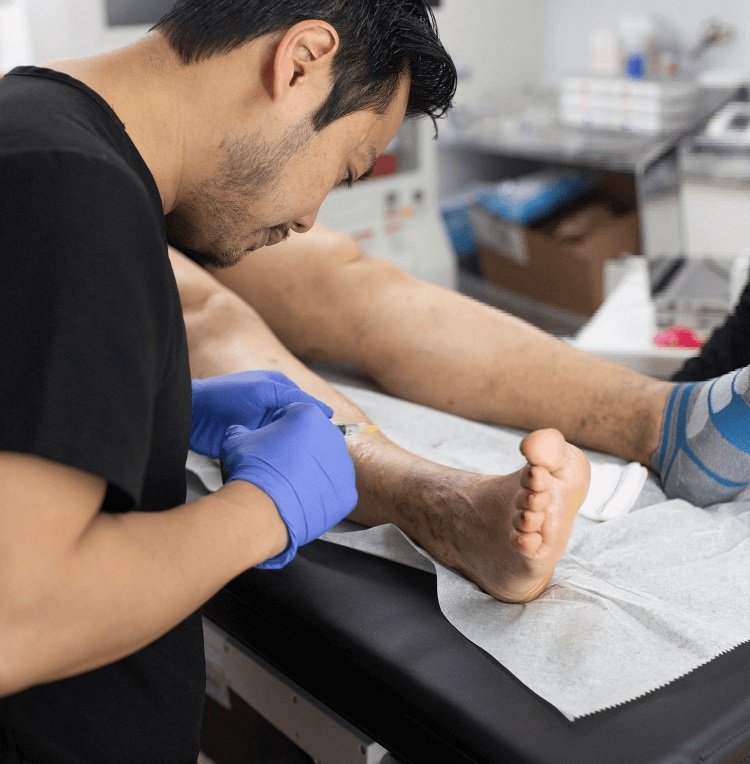If you have been struggling with varicose veins or spider veins, you might wonder: How long is the recovery after vein treatment New Jersey? The answer depends on the type of treatment you choose, your vein health, and your body’s natural healing ability. Fortunately, with modern medical advancements, most patients can resume normal activities quickly. Let’s explore the recovery timeline, what to expect after different procedures, and why seeking professional care makes a difference.
What Are the Treatment Options for Varicose Veins?
When asking, what are the treatment options for varicose veins, it’s important to know that several minimally invasive procedures exist today. Gone are the days when vein stripping surgery was the only choice. Now, treatments are safe, quick, and require very little downtime.
Here are some of the most common procedures available at Vein Treatment New Jersey and other modern clinics:
- Endovenous Laser Ablation (EVLA): Uses laser energy to seal off problematic veins.
- Radiofrequency Ablation (RFA): Uses heat energy delivered through a catheter to close the diseased vein.
- Sclerotherapy: Involves injecting a special solution to collapse spider veins and small varicose veins.
- VenaSeal™ Closure System: A medical adhesive seals the vein without heat or injections.
- Ambulatory Phlebectomy: Small incisions are made to remove larger surface veins.
Each of these treatments offers different recovery timelines, but most allow you to walk out of the clinic the same day.
How Long Is the Recovery After Endovenous Laser or Radiofrequency Ablation?
If you undergo endovenous laser ablation (EVLA) or radiofrequency ablation (RFA) in New Jersey, you can expect a fairly short recovery. These procedures are minimally invasive, performed under local anesthesia, and usually last less than an hour.
- Same-day activity: You can typically return to light walking right after the procedure.
- Work and daily routine: Most patients go back to work within 1–2 days.
- Exercise: Light workouts are possible after 4–5 days, while strenuous exercise may need a week.
- Full healing: Bruising and tenderness fade within 1–2 weeks.
Compared to traditional surgery, recovery is significantly faster, making these treatments highly popular among working professionals in New Jersey.
What About Recovery After Sclerotherapy?
Sclerotherapy is one of the most common treatments for spider veins and small varicose veins. The recovery is quick because the procedure involves only tiny injections.
- Walking: Encouraged immediately after the procedure to promote blood circulation.
- Return to work: Most patients resume work the same day or the next day.
- Side effects: Mild itching, redness, or bruising may occur but usually resolve within a week.
- Final results: Visible improvements often appear within 3–6 weeks, depending on vein size.
Since there are no surgical incisions, the downtime is minimal, making it an excellent choice for patients who want fast results with little interruption to daily life.
How Does Recovery Differ for VenaSeal™?
The VenaSeal™ Closure System is a newer treatment option for varicose veins. It uses medical adhesive to close diseased veins without the need for heat-based energy.
- Immediate mobility: Patients can walk right away.
- Work and daily life: Return to normal activities the same day.
- Compression stockings: Unlike other treatments, they are usually not required.
- Full recovery: Bruising and discomfort are minimal compared to other procedures.
For patients in New Jersey looking for convenience and minimal downtime, VenaSeal™ offers one of the easiest recovery experiences.
What Is the Recovery Timeline for Ambulatory Phlebectomy?
For larger, bulging varicose veins, doctors may recommend ambulatory phlebectomy. This minor surgical procedure removes veins through tiny incisions.
- Walking: Encouraged the same day.
- Work: Most patients return to work in 2–3 days.
- Bruising and swelling: More noticeable compared to other treatments but usually fade in 2–3 weeks.
- Exercise: Avoid strenuous activity for 1–2 weeks.
Though the recovery is slightly longer, the results are immediate and long-lasting.
What Should You Expect During Recovery?
Regardless of the treatment option, the recovery after vein treatment in New Jersey typically includes:
- Compression stockings: Often recommended for 1–2 weeks to support healing.
- Walking: Encouraged daily to improve circulation and reduce the risk of blood clots.
- Mild discomfort: Temporary soreness, bruising, or tightness in the treated area.
- Follow-up visits: To ensure the veins are closing properly and healing is progressing well.
Patients generally notice improved symptoms—such as less heaviness, swelling, and pain—within days to weeks after the procedure.
How Soon Will You See Results?
Many patients want to know when their legs will look and feel better. The timeline varies based on treatment type:
- Sclerotherapy: Visible results in 3–6 weeks for small veins, larger veins may take 3–4 months.
- EVLA or RFA: Results appear in 2–3 weeks as the body absorbs closed veins.
- VenaSeal™: Immediate relief of symptoms, with cosmetic results improving over weeks.
- Ambulatory Phlebectomy: Immediate vein removal, but bruising may take 2–3 weeks to fade.
The good news is that all these procedures not only improve the appearance of your legs but also reduce pain, swelling, and the risk of complications from untreated varicose veins.
Why Choose Professional Care in New Jersey?
Choosing a reputable clinic such as Vein Treatment New Jersey ensures you receive personalized care and the most advanced treatment options. Vein specialists evaluate your vein condition using ultrasound before recommending the best procedure.
Professional care matters because:
- You get accurate diagnosis and tailored treatment.
- Recovery times are shorter with minimally invasive options.
- Risks of recurrence are minimized.
- Cosmetic results are more effective.
Patients who try home remedies alone often see temporary relief but not long-term results. A specialist can treat the root cause of vein disease, giving you lasting comfort and healthier legs.
Final Thoughts: How Long Is the Recovery After Vein Treatment in New Jersey?
So, how long is the recovery after vein treatment in New Jersey? For most modern procedures, the recovery is surprisingly quick. Many patients walk out of the clinic and resume daily activities the same day or within a few days. The exact timeline depends on the procedure—sclerotherapy and VenaSeal™ offer the fastest recovery, while ambulatory phlebectomy may require a bit more downtime.
With today’s advanced medical technology, there’s no need to suffer from the pain, swelling, or cosmetic concerns caused by varicose veins. By consulting specialists and asking what are the treatment options for varicose veins, you can find a solution that fits your lifestyle and health needs.
Whether you want fast recovery, minimal downtime, or long-lasting results, Vein Treatment New Jersey offers expert care tailored to your condition. Take the first step today, and you’ll be on your way to healthier, pain-free legs with a smooth recovery process.
Related Reads
- Comprehensive Pulmonary Function Test Services in Delhi – JCS Lung & Sleep Centre
- Best Lotions for Fibromyalgia Back Pain Relief in 2025
- How to diagnose common ac problems before calling a pro?
- Rent at 1054 Oxford Street East Unit B: Modern Living in a Prime London Location
- Solid Color Flooring in Maui: A Modern Choice for Homes and Businesses



